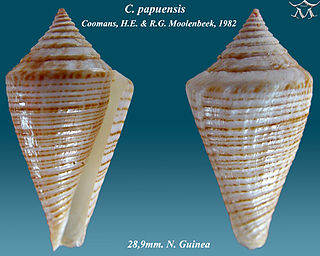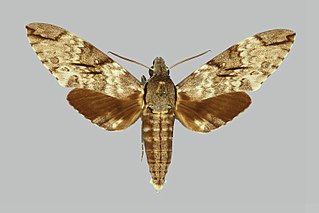
Archbold's bowerbird is a medium-sized, dark grey songbird with brown iris, grey feet and black bill. They can grow up to 37 cm long. The male has narrow black scalloping with some trace of golden yellow crown feathers and dark grey forked tail, that shorter than the wing. Both sexes are similar. The female is smaller than male, with yellow patch on wings and has no crown feathering.

The golden-tipped bat is a species of Microchiropteran in the family Vespertilionidae. It is found in Papua New Guinea and in Australia, especially scattered along the eastern part of Australia. The species is considered uncommon, and is listed as endangered in Australia.
The three-toed swiftlet or Papuan swiftlet is a species of swift. It is found in New Guinea.
The Papuan nightjar or Papuan eared-nightjar is a species of nightjar in the family Caprimulgidae. It is found in New Guinea. Its natural habitats are subtropical or tropical moist lowland forests and subtropical or tropical mangrove forests.

The Papuan frogmouth is a species of bird in the family Podargidae, found in the Aru Islands, New Guinea, and in Cape York Peninsula, Queensland, Australia.

The Papuan bandicoot is a species of marsupial in the family Peramelidae. It is endemic to the Bird's Tail Peninsula. Its natural habitat is subtropical or tropical dry forests. M. papuensis is a small bandicoot with a soft coat with a clear back, upper torso and face stripes. Its head to body length is 18–21 cm (7.1–8.3 in), the tail is 14–16 cm (5.5–6.3 in) long, the hind foot is from 43 to 47 mm long, the ears are 25 to 28 mm long and the animal weighs 145–184 g (5.1–6.5 oz).

Spilocuscus is a genus of marsupial in the family Phalangeridae. Its members are found on the Cape York Peninsula of Australia, New Guinea, and smaller nearby islands. It contains the following species:

The Waigeou cuscus or Waigeou spotted cuscus is a species of marsupial in the family Phalangeridae. It is endemic to the island of Waigeo in Indonesia, and consequently the spelling Waigeo cuscus is often used instead of Waigeou cuscus. Unlike all other members of the genus Spilocuscus, both genders are whitish with black spots. It remains fairly common, but its small range makes it vulnerable to habitat loss and hunting.

Troides oblongomaculatus, the oblong-spotted birdwing, is a birdwing butterfly found in Indonesia and New Guinea.

Conus papuensis is a species of sea snail, a marine gastropod mollusk in the family Conidae, the cone snails and their allies.

Psilogramma papuensis is a moth of the family Sphingidae. It is known from New Guinea and north-eastern Australia.

The Australian emperor dragonfly, also known as the yellow emperor dragonfly, scientific name Anax papuensis, is a species of dragonfly in the Aeshnidae family. It is black with yellow dots along its tail.
Copelatus papuensis is a species of diving beetle. It is part of the genus Copelatus in the subfamily Copelatinae of the family Dytiscidae. It was described by J. Balfour-Browne in 1939.
Diallus is a genus of longhorn beetles of the subfamily Lamiinae, containing the following species:
Paraperipatus is a genus of velvet worms in the family Peripatopsidae. The number of legs vary within species as well as among species in this genus and can range from as few as 21 pairs up to 27 pairs in males and 29 pairs in females. The maximum number of leg pairs recorded in this genus (29) is also the maximum number of leg pairs found in the family Peripatopsidae. This genus exhibits matrotrophic viviparity, that is, mothers in this genus retain eggs in their uteri and supply nourishment to their embryos, but without any placenta. Species in this genus are found in New Guinea and Maluku, Indonesia.
Diallus guttatus is a species of beetle in the family Cerambycidae. It was described by Francis Polkinghorne Pascoe in 1885. It is known from Moluccas.
Diallus lugens is a species of beetle in the family Cerambycidae. It was described by Francis Polkinghorne Pascoe in 1866. It is known from Moluccas.
Diallus gebehensis is a species of beetle in the family Cerambycidae. It was described by Stephan von Breuning in 1957. It is known from Moluccas.
Diallus quadrimaculatus is a species of beetle in the family Cerambycidae. It was described by Stephan von Breuning in 1942. It is known from Papua New Guinea.
Paraperipatus papuensis is a species of velvet worm in the Peripatopsidae family. This species is a pale greenish blue. Females of this species may have as few as 21 pairs of legs or as many as 29 pairs, exhibiting the greatest intraspecific variation in leg number found in any peripatopsid species. Males of this species range from 21 to 27 leg pairs. The maximum number of leg pairs recorded in this species (29) is also the maximum number of leg pairs found in the family Peripatopsidae. Females range from 22 mm to 83 mm in length, whereas males range from 19 mm to 45 mm. The type locality is in Western New Guinea, Indonesia.









